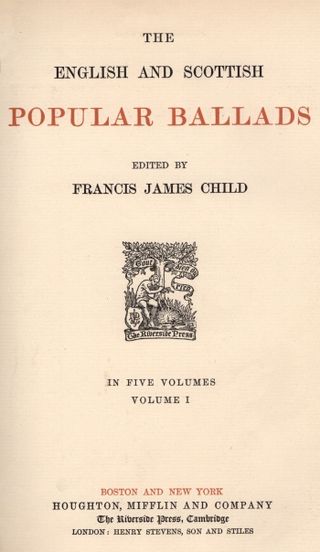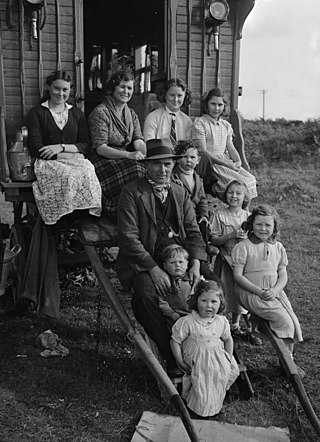Related Research Articles

The Romani, also spelled Romany or Rromani and colloquially known as the Roma, are an ethnic group of Indo-Aryan origin who traditionally lived a nomadic, itinerant lifestyle. Linguistic and genetic evidence suggests that the Romani originated in the Indian subcontinent, in particular the region of present-day Rajasthan. Their subsequent westward migration, possibly in waves, is now believed by historians to have occurred c. 1000 CE. Their original name is from the Sanskrit word डोम, ḍoma and means a member of the Dom caste of travelling musicians and dancers. The Roma population moved west into the Ghaznavid Empire and later into the Byzantine Empire. The Roma are thought to have arrived in Europe around the 13th to 14th century. Although they are widely dispersed, their most concentrated populations are located in Bulgaria, Hungary, Romania, Spain, and Turkey.

Baildon is a town and civil parish in the Bradford Metropolitan Borough in West Yorkshire, England and within the historic boundaries of the West Riding of Yorkshire.

Romani music is the music of the Romani people who have their origins in northern India but today live mostly in Europe.
Pikey is an ethnic slur referring to Gypsy, Roma and Traveller people. It is used mainly in the United Kingdom and in Ireland to refer to people who belong to groups which had a traditional travelling lifestyle. Groups referred to with this term include Irish Travellers, English Gypsies, Welsh Kale, Scottish Lowland Travellers, Scottish Highland Travellers, and Funfair Travellers. These groups consider the term to be highly offensive.

Francis Hindes Groome was a writer and foremost commentator of his time on the Romani people, their language, life, history, customs, beliefs, and lore.
Angloromani or Anglo-Romani is a mixed language of Indo-European origin involving the presence of Romani vocabulary and syntax in the English used by descendants of Romanichal Travellers in the United Kingdom, Australia, Canada, New Zealand, United States, and South Africa.

"The Raggle Taggle Gypsy" (Roud 1, Child 200), is a traditional folk song that originated as a Scottish border ballad, and has been popular throughout Britain, Ireland and North America. It concerns a rich lady who runs off to join the gypsies (or one gypsy). Common alternative names are "Gypsy Davy", "The Raggle Taggle Gypsies O", "The Gypsy Laddie(s)", "Black Jack David" (or "Davy") and "Seven Yellow Gypsies".

The Romanichal are a Romani subgroup within the United Kingdom and other parts of the English-speaking world. Most Romanichal speak Angloromani, a mixed language that blends Romani vocabulary with English syntax. Romanichal residing in England, Scotland, and Wales are part of the Gypsy, Roma, and Traveller community.

Rodney "Gipsy" Smith MBE was a British evangelist who conducted evangelistic campaigns in the United States and Great Britain for over 70 years. He was an early member of The Salvation Army and a contemporary of Fanny Crosby and acquaintance of G. Campbell Morgan and H. A. Ironside.

The Romani flag or the flag of the Roma is the international ethnic flag of the Romani people, historically known as "Gypsies", which form a stateless minority in countries across Eurasia, Africa, the Americas, and Australasia. It was approved by the representatives of various Romani communities at the first and second World Romani Congresses (WRC), in 1971 and 1978. The flag consists of a background of blue and green, representing the heavens and earth, respectively; it also contains a 16-spoke red dharmachakra, or cartwheel, in the center. The latter element stands for the itinerant tradition of the Romani people and is also an homage to the flag of India, added to the flag by scholar Weer Rajendra Rishi. It superseded a number of tribal emblems and banners, several of which evoked claims of Romani descent from the Ancient Egyptians.

A vardo is a four-wheeled horse-drawn vehicle traditionally used by travelling Romanichal as their home. The name vardo is a Romani term believed to have originated from the Ossetic wærdon meaning cart or carriage. It is pulled by a single horse in shafts, sometimes with a second horse hitched on its right side outside the shafts to help pull heavier loads or assist in pulling up a hill. The vehicle is typically highly decorated, intricately carved, brightly painted, and even gilded. The Romanichal tradition of the vardo is seen as a high cultural point of both artistic design and a masterpiece of woodcrafter's art.
The title King of the Gypsies has been claimed or given over the centuries to many different people. It is both culturally and geographically specific. It may be inherited, acquired by acclamation or action, or simply claimed. The extent of the power associated with the title varied; it might be limited to a small group in a specific place, or many people over large areas. In some cases the claim was clearly a public-relations exercise. As the term Gypsy is also used in many different ways, the King of the Gypsies may be someone with no connection with the Roma.
Scottish Romani are the Romani people of Scotland. This includes Romanichal and Lowland Roma.

The Kale are a Romani subgroup predominantly found in northwestern Wales, specifically in the Welsh-speaking areas. Many Kale claim to be descendants of Abram Wood, the first Rom to reside permanently and exclusively in Wales in the early 18th century, although Romanichal have appeared in Wales since the 16th century. Romanichal inhabit South Wales and North East Wales.
The Romani people are known by a variety of names, mostly as Gypsies, Roma, Tsinganoi, Bohémiens, and various linguistic variations of these names. There are also numerous subgroups and clans with their own self-designations, such as the Sinti, Kalderash, Boyash, Manouche, Lovari, Lăutari, Machvaya, Romanichal, Romanisael, Kale, Kaale, Xoraxai and Modyar.
The Gordon Boswell Romany Museum is the lifetime's work of Gordon Boswell, who amassed a collection of artefacts, photographs, and several examples of the characteristic Gypsy wagon or Vardo. The museum also operates a number of non-Romany vehicles, including a horse-drawn hearse. The collection is housed at Clay Lake, Spalding in Lincolnshire, England.

Romani Americans are Americans who have full or partial Romani ancestry. It is estimated that there are one million Romani people in the United States. Though the Romani population in the United States has largely assimilated into American society, the largest concentrations are in Southern California, the Pacific Northwest, Southwestern United States, Texas, Louisiana, Florida and the Northeast as well as in cities such as Chicago, Cleveland, and St. Louis.
Romani cuisine is the cuisine of the ethnic Romani people. There is no specific "Roma cuisine"; it varies and is culinarily influenced by the respective countries where they have often lived for centuries. Hence, it is influenced by European cuisine even though the Romani people originated from the Indian subcontinent. Their cookery incorporates Indian and South Asian influences, but is also very similar to Hungarian cuisine. The many cultures that the Roma contacted are reflected in their cooking, resulting in many different cuisines. Some of these cultures are Middle European, Germany, Great Britain, and Spain. The cuisine of Muslim Romani people is also influenced by Balkan cuisine and Turkish cuisine. Many Roma do not eat food prepared by a non-Roma.

Gheorghe A. Lăzăreanu-Lăzurică or George Lăzurică, also known as Lăzărescu-Lăzurică or Lăzărică, was a leader of the Romani (Gypsy) community in Romania, also remembered for his support of Romania's interwar far-right. Originally a musician and formally trained entrepreneur from an assimilated background, he became conscious about his ethnic roots while serving with the Romanian Land Forces in World War I. A pioneer of Romani-themed literature, he became active within the General Association of Gypsies in Romania in 1933, but broke away that same year to establish the General Union of Roma in Romania. From September 1933 to May 1934, Lăzurică was also a "Voivode of the Gypsies", recognized as such by various local tribes. He and his followers came to resent ethnic designation as "Gypsies", and pleaded for the usage of "Romanies", first proposed to them by Nicolae Constantin Batzaria. Lăzurică himself tried to introduce the term Zgripți as a reference to the people's legendary ancestors.
References
- 1 2 3 4 Paul Petulengro website
- 1 2 3 Bob Smyth, The gypsy told us..., Forest of Dean and Wye Valley Review, 15 July 2009
- ↑ Nicholas Saul and Susan Tebbutt, The Role of the Romanies: Images and 'Counter-Images' of Gypsies, 2004
- ↑ Farnell, Kim (2021). "Xavier Petulengro". Astrology Quarterly (Autumn 2021): 19 – via Academia.edu.
- ↑ Freda Matthews, Gypsies in Leeds and Yorkshire
- ↑ Pathe News: A Romany Wedding on Yorkshire Moors
- ↑ Pathe News: Double Gypsy Wedding at Baildon
- ↑ Pathe News: Funeral of Gypsy Petulengro
Farnell, Kim. "Xavier Petulengro" Astrology Quarterly Autumn 2021 16-20.